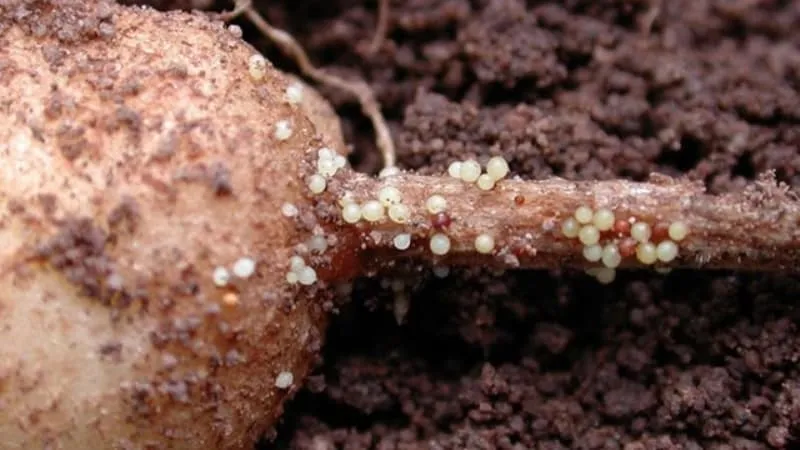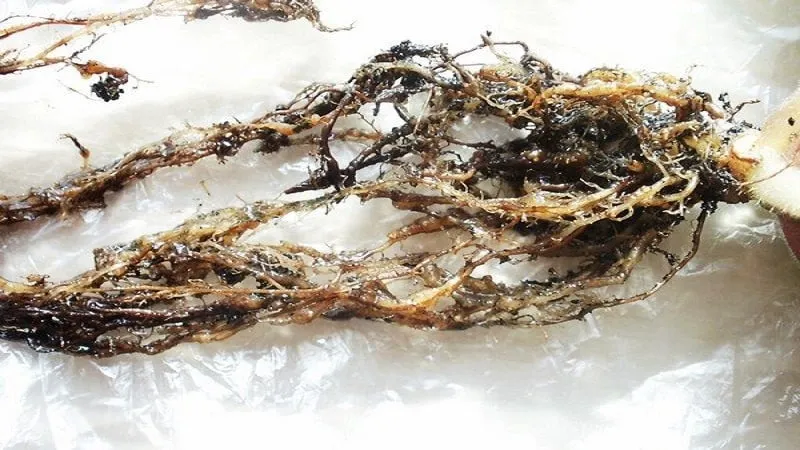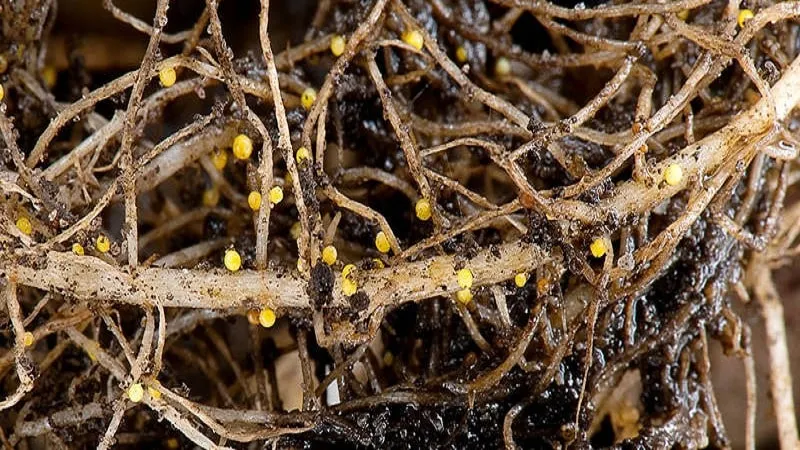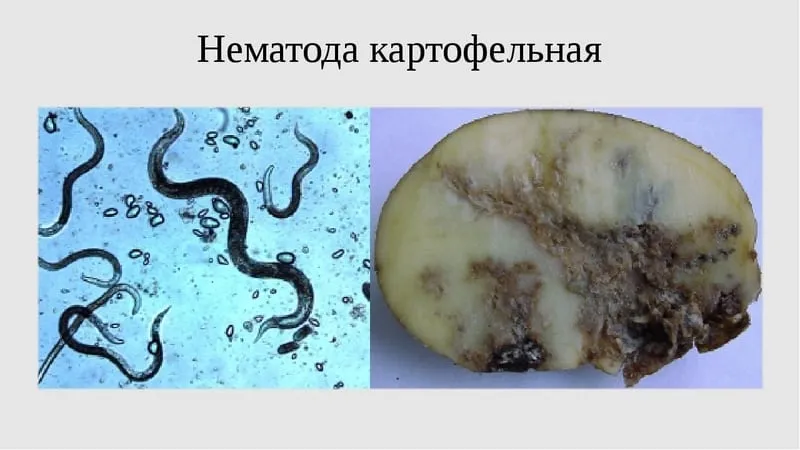Potato nematode was first detected in Europe in the mid-20th century. Initial outbreaks were recorded in Germany and Poland. These microscopic worms are dangerous because, in the early years of soil infestation, they do not affect potato productivity or taste. However, as they multiply and spread across the field, they can destroy over 60% of the crop.
Let’s examine the pest’s characteristics and methods to treat infected plants.
Table of contents
Pest Description
The potato cyst nematode is a quarantined pest belonging to the cyst-forming nematodes of the Heteroderidae family. In addition to potatoes, it affects other Solanaceae plants (eggplants, tomatoes, physalis). Depending on the climate, it produces 1–2 generations per year. Reproduction is bisexual.
These roundworms exhibit pronounced sexual dimorphism (two distinct forms within the same species). Females measure 380–1,070 µm in length and 275–965 µm in width. Their bodies are pearly white and hemispherical or oval in shape. As they develop, their color changes from white to yellow. Upon transitioning into the cyst stage, females turn golden.

Males measure 890–1,270 µm in length and 31–46 µm in width. Their bodies are worm-like and tapered at the ends.
Larvae are 366–570 µm long and 18–26 µm wide, with bodies tapered at both ends.
Adult nematodes live inside potato roots at temperatures of +15…+20°C. Males do not feed—their sole purpose is to find and fertilize a female within 10 days before dying.
A single female produces 200–1,000 eggs, which overwinter in cysts (dead females containing eggs). Cysts detach easily from roots and remain in the soil until spring. At air temperatures of +12°C, larvae emerge and infect potatoes.
One generation develops over 38–48 days. Wet weather with prolonged rains accelerates nematode reproduction.
Types of Nematodes
Several species exist: golden, stem, pale, root-knot, and leaf nematodes. Potatoes are particularly susceptible to golden nematodes.
Golden Nematode
The pest penetrates roots and feeds on plant sap, restricting nutrient flow to stems, foliage, and young tubers. Potato bushes dry from the lower leaves upward. Tubers remain small or fail to form, while roots become excessively branched—a phenomenon known as "root beard."
Males resemble tiny worms. Females have spherical bodies that fill with eggs within 384 days post-fertilization. By autumn, they darken to a golden-brown hue.
Below is an image of the golden potato nematode.

Stem Nematode
This 1.7 mm-long worm infects stems and tubers. Dark spots appear on infected tubers, with loose, pale flesh beneath the skin. The surface cracks, and dry rot develops underneath.
Stem nematodes thrive in excessive moisture and spread in damp cellars, moving from tuber to tuber.
Pale Nematode
Its life cycle mirrors the golden nematode’s, differing only in color. The female’s white body turns brown.
Initial symptoms include sickly-looking bushes with no more than three stems that yellow prematurely. Infection spreads upward from lower leaves, eventually engulfing the entire plant.
Infected plants produce few tubers, each weighing under 40 g.
Root-Knot Nematode
This species attacks potato roots and tubers, as well as cucurbits (zucchini, squash, melons, pumpkins). Tubers develop bumps or growths up to 3 cm in diameter. Infected plants suffer nutrient and water deficiencies.
Leaf Nematode
The smallest species (≤1 mm) with colorless bodies. They move inside plants, facilitating viral infections. Besides potatoes, they parasitize chrysanthemums and tomatoes.
Yellow spots appear on leaves, which later dry and fall. The worms spread through plant wounds.
Symptoms of Infestation

The danger lies in the disease’s stealth. Signs emerge only when pest populations reach critical levels. "Bald patches" appear—yellowed, dried bushes amid healthy foliage. Tubers shrink.
Under magnification, round cysts resembling sand grains become visible. If suspected, submit wilted plants to a lab.
Control Methods
Potato nematodes are notoriously hard to eradicate. European farmers have extensive experience combating them, given their earlier arrival in the region. A combined approach—agronomic practices and chemicals—is essential, though no method guarantees complete elimination.
Note: If your field is under quarantine, strict adherence to rules allows potato cultivation. However, harvests should be consumed locally, not sold elsewhere.
Eradication may take decades, but reducing populations within 1–2 years is feasible.
At 3–5 cysts per 100 cm³ of soil, damage is negligible. Significant yield loss occurs at 10–16 cysts/100 cm³.
Agronomic Measures

Effective strategies include:
- Crop rotation: Avoid planting potatoes consecutively on the same plot. Even with 3–4 year intervals, severe infestations take 40+ years to develop.
- Resistant varieties: Grow them for ≤3 consecutive years before switching to susceptible ones, or rotate resistant cultivars every 4 years.
- Sanitation: Burn infected foliage and weeds in autumn. Disinfect tools with 4% formalin.
- Urea application: Apply in spring/autumn—nitrogen is lethal to nematodes. For minor infestations, bury plant debris in pits layered with urea (5–6 kg/m³) and topped with clean soil.
- Healthy seed potatoes: Wash and treat with potassium permanganate (0.5 g/10 L water).
- Poultry manure: Add 1 tbsp/planting hole or use fresh manure diluted 1:10 for soil drenching.
- Trap crops: Plant rye, beans, peas, marigolds, clover, or mustard nearby. Their roots exude nematode-toxic compounds. Rye sown in mid-October kills 90% of larvae; its decomposing straw enriches soil. Legumes fix nitrogen—sow between rows or in planting holes.
- Earthworms: Boost their populations through soil enrichment—they naturally prey on nematodes.
Chemical Control
For severe infestations, apply chemicals 6 weeks before planting, following manufacturer guidelines.
Potent fungicides like chloropicrin, methyl bromide, and Nemagon (toxic gases) treat soil and seed tubers. They kill nematodes by entering their respiratory systems. Use personal protective equipment (PPE).
Organophosphate nematicides (e.g., Lindane, Malathion, Dimethoate) target stem and leaf nematodes. Apply as seed treatments.
Warning! Due to high toxicity, plant tubers only 20–50 days after chemical application.
Biologics like Basamyl, Phytocit, Nematophagin BT, and Paecilomycin are non-toxic to tubers yet effective against pests.
Home Remedies
Boiling water is the only effective folk method—herbal concoctions fail.
Drench infected soil to 20 cm depth with boiling water, then cover with plastic to slow cooling. This kills shallow-dwelling nematodes but may drive deeper ones to unaffected areas.
Human Health Risks
The pest poses no direct threat, but infested tubers lose flavor and marketability.
Nematode-Resistant Potato Varieties

The table below lists resistant cultivars whose roots kill ~80% of nematodes.
| Variety | Originator | Maturity (days) | Tuber Weight (g) | Yield (t/ha) |
| Limonka | Agrico (Netherlands) | 110–120 | 75–125 | 19–32 |
| Krinitsa | Belarusian Potato Research Centre | 110–120 | 88–136 | 17–28 |
| Red Scarlet | HZPC (Netherlands) | 70–80 | 56–102 | 16–27 |
| Atlant | Belarusian Potato Research Centre | 110–120 | 90–119 | 16–26 |
| Rosara | Saka Pflanzenzucht (Germany) | 50–65 | 81–115 | 20–26 |
| Vesnyanka | Belarusian Potato Research Centre | 110–120 | 93–127 | 24–37 |
| Uladar | Belarusian Potato Research Centre | 50–65 | 91–140 | 13–26 |
| Lileya | Belarusian Potato Research Centre | 65–70 | 102–200 | 25–41 |
| Yanka | Belarusian Potato Research Centre | 90–100 | 81–106 | 20–36 |
| Secura | Solana (Germany) | 80–95 | 59–150 | 20–37 |
| Arizona | Agrico (Netherlands) | 70–80 | 112–150 | 26–58 |
Conclusion
Potato nematodes are formidable pests that can decimate crops if unchecked. While eradication is challenging, integrated management—crop rotation, sanitation, seed treatment, resistant varieties, nitrogen fertilization, chemical nematicides, and hot-water drenching—can drastically reduce populations.







